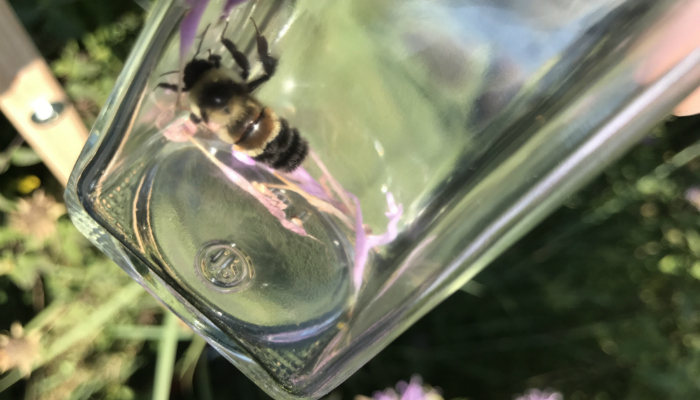Bees Everywhere and Nowhere to Go

A flash of white catches my attention, and my eyes scan in that direction. The diversity of shapes, sizes and colors of prairie plants softly swaying in the gentle breeze is like a kaleidoscope, complicating my ability to single out any one recognizable pattern. I see it again. Satisfied it’s what I’m looking for, I move closer and pull out the small white sweet clover plant (an invasive species), taking care not to disturb the many bumble bees and honey bees busily seeking nectar on the nearby prairie plants. I watch the bees shift from one purple prairie clover plant to the next, clearly demonstrating their superiority in recognizing patterns. Several sedge wrens start calling, but their sharp chips and rapid chatter are muted by the buzz of the bees. I can barely hear the wrens now over the bees. Moments later it dawns on me – I can’t hear anything but bees! Alarmed, I spin around looking for the source of the sound. Uh-oh!
I consider running, but it’s too late. The swarm is widespread and like a storm cloud hugging the ground, closing rapidly. With nowhere to go, I figure my best bet is to stay still and let them pass. The first wave of honey bees shoots past my head and shoulders. Initially, I can make out individual bees as they pass, but it all turns into a blur as I’m inundated by thousands of bees. I stay still and calm; honey bees are gentle, and it will pass soon, I think. But it’s not passing quickly, and I’m noticing a rotational pattern in the bees’ movements. Mesmerized, I watch the “bee cloud” metamorphose into a rotating mass with its base at the height of my shoulder and slowly stretching into the sky before plateauing at approximately 100 feet. The mass moves as a single organism; its middle undulating back and forth as the top and base stay in a fixed position. Is this towering organism studying me?
The honey bee is not native to North America and was introduced in the early 17th century by Europeans for honey and wax production. The honey bee is vitally important to commercial agriculture and, according to the U.S. Department of Agriculture, is responsible for pollinating 80% of our flowering crops, which constitutes one-third of everything we eat. According to the Xerces Society for Invertebrate Conservation, native bees (approximately 4,000 species in North America) are also important crop pollinators. Native, unmanaged bees provide free pollination services, and are often more efficient than honey bees on an individual bee basis at pollinating particular crops, such as squash, berries and tree fruits.
In addition to agriculture, pollinators are vitally important species in most ecosystems. Their pollination services produce the seeds and fruits that feed nearly all terrestrial animal life and sustains the next generation of plants. Therefore, conservation of pollinating insects is critically important to conserving both biodiversity and agriculture.
While the decline in honey bee populations is well known and potentially contributed to factors such as colony collapse disorder, parasites, disease and pesticides; little is known about the status of native bee populations. Science is trying to catch up. On March 21, 2017, the U.S. Fish and Wildlife Service listed the rusty patched bumble bee (Bombus affinis) as an endangered species under the Endangered Species Act. It’s the first bumble bee species to be given that status, and the first wild bee of any kind to be listed in the lower 48 states. The International Union for the Conservation of Nature ranks the rusty patched bumble bee as one of 47 species of native U.S. and Canadian bumble bees, more than a quarter of which face risk of extinction. Habitat loss and fragmentation, along with climate change all appear to be factors in the decline of native bumble bees, according to the Xerces Society.
Does a natural land’s manager need to be concerned about the potential risks (nectar and pollen competition, disease transmission, preference for invasive plant species such as sweet clover) honey bees pose to native bees, plant communities and other wildlife? The Xerces Society recommends the following:
“Because of the potential threats to our native pollinators, until additional evidence exists documenting that honey bees have a net neutral effect on our native biota, we urge land managers to consider these potential impacts and their relevance when making a decision about the placement of apiaries (collection of bee hives) on public lands and natural areas.”
~ An overview of the potential impacts of honey bees to native bees, plant communities, and ecosystems in wild landscapes: Recommendation for land managers, Xerces Policy Statement, Aug. 18, 2016
It doesn’t take me long to realize the communal-think organism hovering above isn’t interested in me but rather the large, open-grown bur oak tree next to me. Its top begins to lower, its base rises, and the middle undulates in ever-widening waves. Soon, it loses its tall, vertical form as it stretches out in a horizontal, elliptical shape hovering about 40 feet above the ground. Minutes later, the floating elliptical organism tightens into a rotating ball and seemingly attaches itself to a tree branch. A resting queen honey bee surrounded by thousands of workers, I think.
Staring at the feral “hive” of honey bees, I once again find myself lost in the complexities of caring for a rare ecosystem in an ever-shrinking natural world. Do I consider the feral honey bees as friend or foe? Yet another unanswered question in a sea of unknowns makes me feel as small and insignificant as the lands I care for.
I move on to the next sweet clover plant.
Originally published on Environmental Returns


